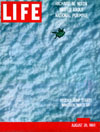
 |
|
|
| Parachute Safety System For Commercial Airlines | ||
|
Nov 22, 1996 a San Francisco man is preparing to make a world record parachute jump as a means of demonstrating the feasibility of parachutes as a safety mechanism for distressed commercial aircraft. Roy t. Maloney, a former paratrooper, plans to make the jump from a height of 30 miles. The procedure will involve a ballistically deployed mini-space capsule that will contain a velocity controlled, barometrically released parachute. After it is released from a space capsule, Maloney then has the option of jumping from the capsule, or landing with it. "I plan to show that parachutes are a viable safety device under extreme aviation conditions. By setting world records for the highest parachute jump, the longest free fall and the fastest human without mechanical means, I intend to prove that parachutes can be used to save lives when used on sophisticated aircraft when applied in strategic manner." Maloney says he has no plans of setting a fourth record, namely longest free fall without parachute. Similar feat was accomplished in 1960 when col. Joseph Kittinger made a free fall of over 16 miles from the gondola of a hot air balloon, positioned nearly 20 miles above the earth. Maloney believes he can demonstrate a possible emergency safety procedure from a space shuttle for optional use by astronauts. |
 |
|
 |
||
 |
 |
"By realizing the full potential of parachutes as a safety mechanism, the loss of life in air disasters can be mitigated. Pilots of distressed aircraft will have at their disposal an emergency parachute system (EPS), allowing them to glide-path land troubled airplanes like a cream puff, simply by pulling a handle, or handles and releasing a series of parachutes strategically placed on the aircraft...using up to 5 parafoils on a 747, or commercial airliner." "Modular parafoils (wing parachutes) can be zippered together, to form any size, for any application." "The option of pulling a 45 pound handle is preferred to turning a multi-million dollar commercial airliner into little bits of charred metal, especially considering the loss of life," Maloney said. He is not interested in financial gain, or selling a product, only in saving lives and visibility for the system. Maloney has already gained praise from respected members of the aircraft industry, Peter A. Johnson, a former aircraft carrier pilot and aircraft consultant with Dixville notch consultants, inc. In Campton, New Hampshire says, "your system could very well be a generic solution to the aircraft industry." Jay Willmott, vice president, Bai Aerosystems, Inc., Leaders in the world for UAV's says, "i believe your system of chutes for a 747 makes sense, since we are already using parafoil chutes on the wing of our unmanned aerial vehicles." |
|
| ŠAvStop Online Magazine Contact Us Return To News | ||